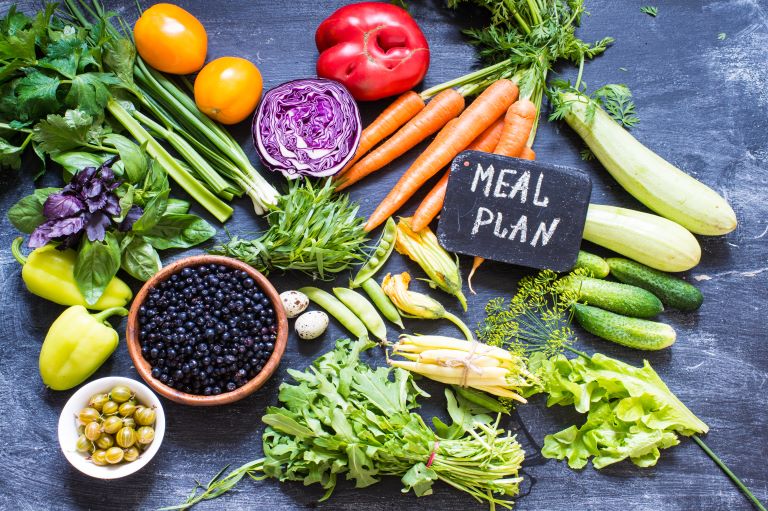Are you sure you want to leave 's MyShop site?
Are you sure you want to leave 's MyShop site?
Are you sure you want to leave 's MyShop site?
Are you sure you want to leave 's MyShop site?

March is National Nutrition Month—a month dedicated to the practice of healthy eating. Each year has a new theme, and this year’s theme is Personalize Your Plate. According to the Academy of Nutrition and Dietetics:
This month, dietitians are encouraging people to learn about making informed food choices and develop healthful eating habits. Here are some tips provided by the Academy of Nutrition and Dietetics to help you start your journey to more personalized food choices:

Include healthful foods from all food groups. Your body requires a variety of nutrients to support its many functions. It needs macronutrients (carbohydrates, protein, and fat), micronutrients (vitamins and minerals), phytonutrients (natural compounds found in plants), and water. To ensure you are getting enough of these essential nutrients, try to fill your plate with foods from each food group—vegetables, fruits, grains, proteins, and dairy.
Hydrate healthfully. Water makes up about 60% of your body. It is part of every body system and is critical to your survival in many ways. The best way to keep yourself hydrated is to drink water. Other hydration sources include milk, tea, coffee, fruit juices, soda, and sports drinks. Many of these options contain added sugars, so it is best to drink them in moderation. Foods, such as fruit and soup, can also provide hydration, but they only do so in small amounts, so keep drinking your water!
Read Nutrition Facts Panels. Knowing what’s in the food you eat is important, especially if you are trying to improve your health. Though many packaged foods claim to be “healthy,” their nutrition labels may suggest otherwise. Try to limit foods with a lot of added sugars. You can find this information under the Total Carbohydrate section of a nutrition label. Avoid products that include trans fat. Look for this information under the Total Fat section. A good rule of thumb is to reach for whole or minimally processed foods as much as possible and when eating processed (packaged) foods, always read the nutrition label before buying or consuming.
Avoid distractions while eating. While multitasking may seem like a good idea, it is rarely beneficial, especially when food is involved. Your attention is a limited resource and when it’s divided between eating and something else, hunger and fullness cues that keep your appetite in check can go unnoticed. Distracted eating is a major culprit of overeating, so it should be avoided.
Take time to enjoy your food. Despite being one of the more pleasurable things in life, eating has become somewhat of a chore for many of us. Between work, school, family, and all the other things on your to-do list, it seems there is little time to really enjoy food. Two downsides of rushing through meals or skipping them altogether are poor food choices and potentially overeating. To promote healthy food choices and prevent overeating, take a few extra minutes to really enjoy your food.

Use a grocery list. The first step here is to choose your recipes for the week. Pick about three to four recipes, keeping in mind that you’ll likely have leftovers and potentially a day of eating out. Next, identify which ingredients you have at home and which ones you need from the grocery store. Making a list helps you buy only what you need and reduces your number of trips to the store throughout the week.
Choose healthful recipes to make during the week. Making healthful meals can be easy. Before your week starts, pick a few recipes, gather the ingredients, and do any prep work possible. Cutting up vegetables, putting together marinades, or even cooking the entire dish and refrigerating or freezing can all be done ahead of time. After a long day, it can be hard to find the energy to decide what to eat, let alone cook it. Putting in the effort on your less busy days will save you from making extra decisions during the week and can make cooking more enjoyable.
Enjoy healthful eating at school and work. As mentioned above, taking time for a little extra food prep at the beginning of the week makes it easier to eat healthy. In addition to prepping your weeknight dinners, put together meals and snacks you can take on-the-go. Invest in good food containers to keep your fridge organized and your food fresh. When picking containers to use for to-go meals, find ones that promote portion control. This will help prevent overeating and food waste.
Plan healthful eating while traveling. When traveling, research the area before you leave and find local shops that serve healthy food options. If you are staying somewhere with a kitchen, find a nearby grocery store where you can buy ingredients to make your own meals. This is a good way to save money, since eating out can be costly.

Keep healthful ingredients on hand. To make eating healthier easier, stock your fridge and pantry full of nutritious ingredients. Keep lots of fruits and vegetables on hand, canned or fresh. Fill your freezer with different meat options (e.g., chicken, fish, or beef). Dairy items like milk, yogurt, and cheese are great for cooking and baking. Buy whole grain breads, crackers, and pasta. Other healthy items to have around include eggs, nuts, oatmeal, dried fruits, hummus, and nut butter.
Practice proper food safety. Food should taste good and make you feel good. To prevent food illnesses, the U.S. Food and Drug Administration recommends following these four steps: 1) clean – always wash your food, hands, counter, and cooking tools 2) separate – keep raw foods separate to avoid the spread of germs 3) cook – cook foods to safe temperatures (typically between 145–165 degrees Fahrenheit) 4) chill – put food into the fridge or freezer within two hours after cooking or buying from the store and thaw foods in the fridge, under cold water, or in the microwave.
Share meals together as a family when possible. Sitting down for a meal together is beneficial for several reasons: It provides time to catch up and connect with family members. It can be used a time to teach kids about food and the importance of healthful eating habits. Kids learn valuable life skills when involved in the planning, shopping, and preparing of meals. Also, both kids and adults tend to eat more mindfully when in the presence of others. This can be good for appetite regulation and promotes building a healthy relationship with food.
Reduce food waste. To cut back on food waste, get creative in the kitchen. Get inspired from recipes and then come up with your own version based on ingredients you have in your fridge and pantry. Unlike baking, cooking is more of an art than a science. Measurements don’t need to be perfect and ingredients can easily be added or removed. Stir fries are a great way to use leftover vegetables, meat, and rice. Try designating one dinner each week as a “use-it-up” meal. This will help you go through all the food items that are about to spoil.
Try new flavors and foods. To keep things interesting, venture out and try new foods. When eating out, order unfamiliar foods, and if you find something you like, try to recreate the recipe at home. There are thousands of food blogs, cooking shows, and cookbooks that can teach you different ways to prepare food.
Making informed food choices and developing healthful eating habits doesn’t have to be hard, it just takes a little know-how and practice. Use the recommendations above to guide your efforts and soon enough, you’ll find an approach to eating that works best for you. Remember, there is no one-size-fits all approach to nutrition and health.
You are trying to view a MyShop page. Please log out in order to view this website.